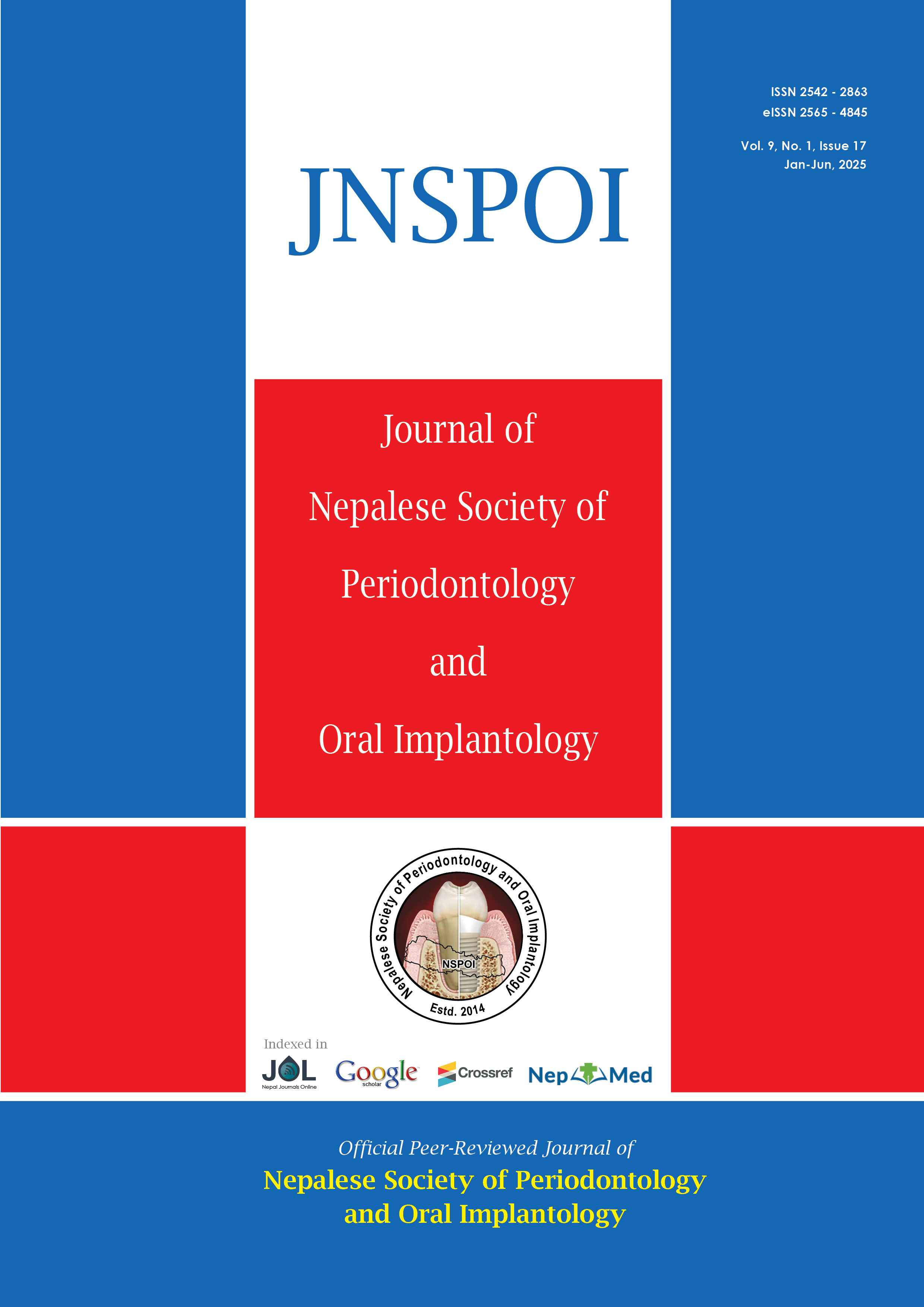Abstract
Introduction: Presentation of dental disease varies depending on different cultural practices, conditioning, awareness, and a person’s
attitude towards seeking oral health care services. Lack of oral hygiene practices, feeding at will, and excessive consumption of sweets lead
to early tooth decay.
Objective: To assess pattern of distribution of various oral health conditions among children.
Methods: This hospital-based, analytical, cross-sectional study was carried out among 431 children from one week to 14 years old in the
department of Paedodontics and Preventive Dentistry, Universal College of Medical Sciences, Siddharthanagar from 2025 January to June
after obtaining institutional ethical clearance. Informed consent and assent were obtained from parents and children before enrolment
in this study. Participants were selected using convenience sampling method and divided into two groups: group I included 211 children
aged one week to six years and group II ranged from seven years to 14 years of age comprising of 220 children. Distribution of disease
depending upon presenting complaints was recorded over a period of six months. The data collected were tabulated and subjected to
statistical analyses using SPSS v.20 Descriptive statistics were obtained and frequency distribution were calculated. Chi-square test was
used for the analysis.
Results: Out of total study population,166 (38.5%) children showed presence of dental caries, 105 (24.4%) had dentoalveolar abscess.
Children presented with retained deciduous were 49 (11.4%), whereas 36 (8.4%) complained mobility, 24 (5.6%) cases were of trauma, and 14
(3.2%) malocclusions followed by 13 (3%) gingivitis, 12 (2.8%) developmental anomalies, seven (1.6 %) pericoronitis, four (0.9 %) precocious
teeth, and one (0.2%) tongue tie as their chief complaint
Conclusions: The present study highlights that dental caries and dentoalveolar abscess were most frequently reported oral health problems
among children, particularly in younger age group. Male children showed higher prevalence of traumatic dental injuries.
References
2. Humagain M. Evaluation of knowledge, attitude and practice (KAP) about oral health among secondary level students of rural Nepal: A questionnaire study. Webmed Central Dent. 2011;2(3):WMC001805.
3. Peedikayil FC. Role of paediatricians in oral disease prevention. Karnataka Paediatr J. 2022;37(3):73-8.
4. Khanal S, Shah P, Ghimire P. Burden of dental caries in the Nepalese children: A literature review. J Nepal Assoc Pediatr Dent. 2021;2(2):90-6.
5. Suttagul K, Rokaya D, Rokaya N, et al. Prevalence of dental caries and oral hygiene practice in school children of Bhaktapur, Nepal. World J Med Sci. 2016;13(2):217-21.
6. GBD 2017 Disease and Injury Incidence and Prevalence Collaborators. Global, regional, and national incidence, prevalence, and years lived with disability for 354 diseases and injuries for 195 countries and territories, 1990-2017: A systematic analysis for the Global Burden of Disease Study 2017. Lancet. 2018;392(10159):1789-858.
7. American Academy of Pediatric Dentistry. Policy on early childhood caries (ECC): Classifications, consequences, and preventive strategies. In: The Reference Manual of Pediatric Dentistry. Chicago (IL): American Academy of Pediatric Dentistry; 2020. p. 79-81.
8. Al-Ansari AA. Prevalence, severity, and secular trends of dental caries among various Saudi populations: A literature review. Saudi J Med Med Sci. 2014;2:142-50.
9. Khanal S, Acharya J. Dental caries status and oral health practice among 12-15-year-old children in Jorpati, Kathmandu. Nepal Med Coll J. 2014;16(1):84-7.
10. Khanal S, Acharya J, Gautam S, et al. Pattern of distribution of oral diseases among children in Jorpati, Kathmandu. J Nepal Dent Assoc. 2013;13:33-9.
11. Kassebaum NJ, Smith AGC, Bernabé E, et al. Global, regional, and national prevalence, incidence, and disability-adjusted life years for oral conditions for 195 countries, 1990-2015: a systematic analysis for the global burden of diseases, injuries, and risk factors. J Dent Res. 2017;96(4):380-7.
12. Sharmin S, Alam MK. Presentation pattern for common oro-dental disease trend among children attending a selected pediatric hospital: a cross sectional study. Int Med J. 2021;28(2):258-61.
13. Chaudhary S. Magnitude and pattern of combination traumatic dental injuries: An institution based retrospective study in Nepal. Journal of Gandaki Medical College-Nepal. 2022;15(1):53-8.
14. Patidar D, Sogi S, Patidar DC, et al. Traumatic dental injuries in pediatric patients: a retrospective analysis. Int J Clin Pediatr Dent. 2021; 14(4):506-511.
15. Shah P, Khanal S. Prevalence of traumatic dental injuries among 1-14-year-old children in tertiary care center of Nepal. J Chitwan Med Coll. 2024;14(48):64-7.
16. Zou J, Meng M, Law CS, et al. Common dental diseases in children and malocclusion. Int J Oral Sci. 2018;10(1):7.
17. Pradhan S, Mohanty S, Acharya S, et al. Gingival diseases in children and adolescents. Indian J Forensic Med Toxicol. 2020;14(4):8932-7.
18. Upadhyay M, Agrawal A, Sharma J. Prevalence of mesiodens among Nepalese children. J Dent Panacea. 2024;6(2):107-9.
19. Dhusia AH, Dhusia H. Natal and neonatal teeth: A case series with review of literature. IOSR J Dent Med Sci. 2024;23(9):1-8.

